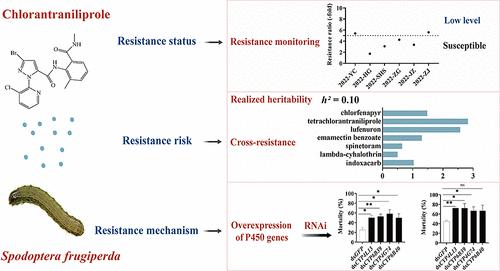当前位置:
X-MOL 学术
›
J. Agric. Food Chem.
›
论文详情
Our official English website, www.x-mol.net, welcomes your
feedback! (Note: you will need to create a separate account there.)
Chlorantraniliprole Resistance in Spodoptera frugiperda: Resistance Monitoring, Resistance Risk, and Resistance Mechanisms
Journal of Agricultural and Food Chemistry ( IF 5.7 ) Pub Date : 2024-07-22 , DOI: 10.1021/acs.jafc.4c03361 Zhimin Guo 1 , Huina Ma 1 , Jiahui Tang 1 , Mengyan Wu 1 , Shun He 1 , Hu Wan 1 , Jianhong Li 1 , Kangsheng Ma 1
Journal of Agricultural and Food Chemistry ( IF 5.7 ) Pub Date : 2024-07-22 , DOI: 10.1021/acs.jafc.4c03361 Zhimin Guo 1 , Huina Ma 1 , Jiahui Tang 1 , Mengyan Wu 1 , Shun He 1 , Hu Wan 1 , Jianhong Li 1 , Kangsheng Ma 1
Affiliation

|
Spodoptera frugiperda is a significant global pest, and chlorantraniliprole (CAP) is extensively used in China for its control. Understanding CAP resistance in S. frugiperda is crucial for effective management of this pest. Field populations exhibited varying degrees of resistance to CAP (RR = 1.74–5.60-fold). After 10 generations of selection, the CAP-resistant strain developed over 10-fold resistance, with a realized heritability (h2) of 0.10. Genetic analysis reveals inheritance patterns as autosomal, incomplete recessive, and monofactorial. The CAP-resistant strain showed limited cross-resistance to lufenuron and tetrachlorantraniliprole, negative cross-resistance to spinetoram, and no observed cross-resistance to other insecticides. Biochemical analysis suggested that P450-mediated detoxification is the primary resistance mechanism, with 26 genes overexpressed in the CAP-resistant strain. Additionally, the knockdown of CYP4L13, CYP6B39, CYP6B40, and CYP4G74 significantly increased the sensitivity of the resistant larvae to CAP. These findings highlight the resistance risk of CAP in S. frugiperda and emphasize the crucial role of P450 enzymes in resistance.
更新日期:2024-07-22











































 京公网安备 11010802027423号
京公网安备 11010802027423号